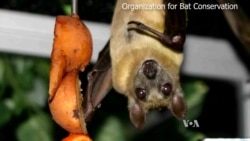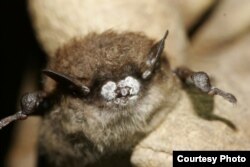North America is home to 45 species of bats, and more than half of them have been devastated by White Nose Syndrome (WNS), an invasive fungus unintentionally brought in from Europe 10 years ago.
The highly contagious fungus has contaminated thousands of North American caves and mines, spreading from one county in New York state to 30 U.S. states and five Canadian provinces, killing 10 million bats in the process.
If scientists cannot find a way to stop it, WNS could become one of the biggest wildlife catastrophes on the continent in the last century. And a catastrophe for humans, too.
"[Bats] do a wide variety of economical and ecological benefits for humans,” said Rob Mies, founder of the Organization for Bat Conservation. “They eat tons of insects. They pollinate plants. They spread seeds."
An insidious invader
Mies says the fungus attacks bats while they hibernate.
"When the bats go in [to hibernate], they hang on the cave wall and the fungus slowly grows on their skin. When it grows on their skin, it eats away at their skin and it dehydrates them," he said.
That causes them to wake repeatedly from hibernation, burning up crucial fat reserves that they need to sustain them until spring, leading to starvation and death.
The fungus originated in Europe, but bats there have some natural immunity, unlike in the U.S., where its introduction has been devastating. WNS mainly attacks the smaller crevice-dwelling species. As the bats fly to new locations, they transfer the fungus to even more populations.
Because bats are found on every continent except Antarctica, scientists warn that if it is not stopped soon, WNS could spread across the world. It can also be spread by people, carrying the fungus on their shoes and clothing as they explore caves.
Fighting back
The Organization for Bat Conservation focuses on teaching people about bats, and mobilizing them to become involved in saving them.
The group holds demonstrations at schools, museums and zoos with live bats, and teaches people how to build bat houses to give the small mammals warm, dry places to raise their young. OBC also produces a guide for planting bat-friendly gardens, with flowers that either stay open through the night or bloom through the evening to attract the night-flying insects the bats eat.
"When people don't kill bats, it keeps the population at a higher level,” Mies said. “Those bats have a higher chance of making it through the winter if they come in contact with this fungus."
Meanwhile, he says, scientists are hard at work trying to find a way to fight White Nose Syndrome.
"We had to figure out ways that we could use nontoxic treatments so that bats would live through it,” Mies said. “But also we didn't want to go into caves and eliminate all the fungus, because that would be bad for the caves, as well. We'd be killing off maybe dozens or hundreds of species just to save one."
Scientists have recently discovered a bacteria that works as a natural fungal inhibitor when sprayed on cave walls. It was tested this past winter, and scientists hope to have results later this spring, as the bats come out of hibernation.
Other approaches are also being tried, from using an automatic spray that bats fly through as they leave caves, to releasing the bacteria into the air of their habitats, to treating the bats' food sources.
Mies says that using all these tools, and finding more, are vital in the fight to save the bats and keep the fungus from devastating even more of the creatures.










